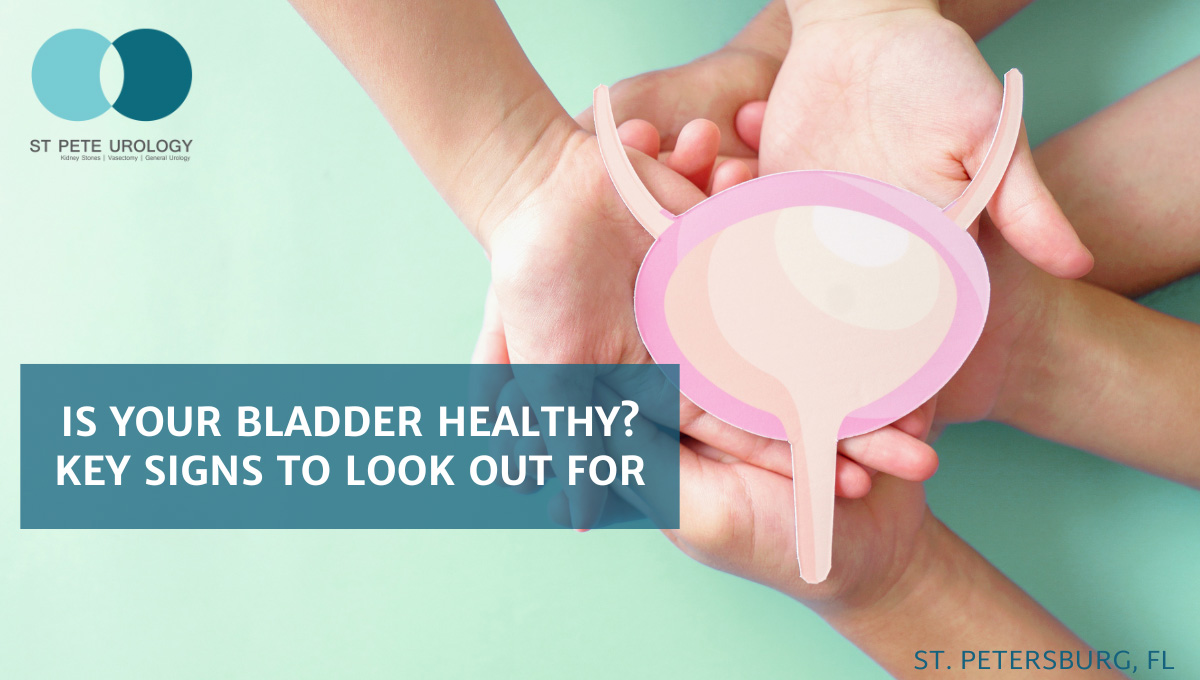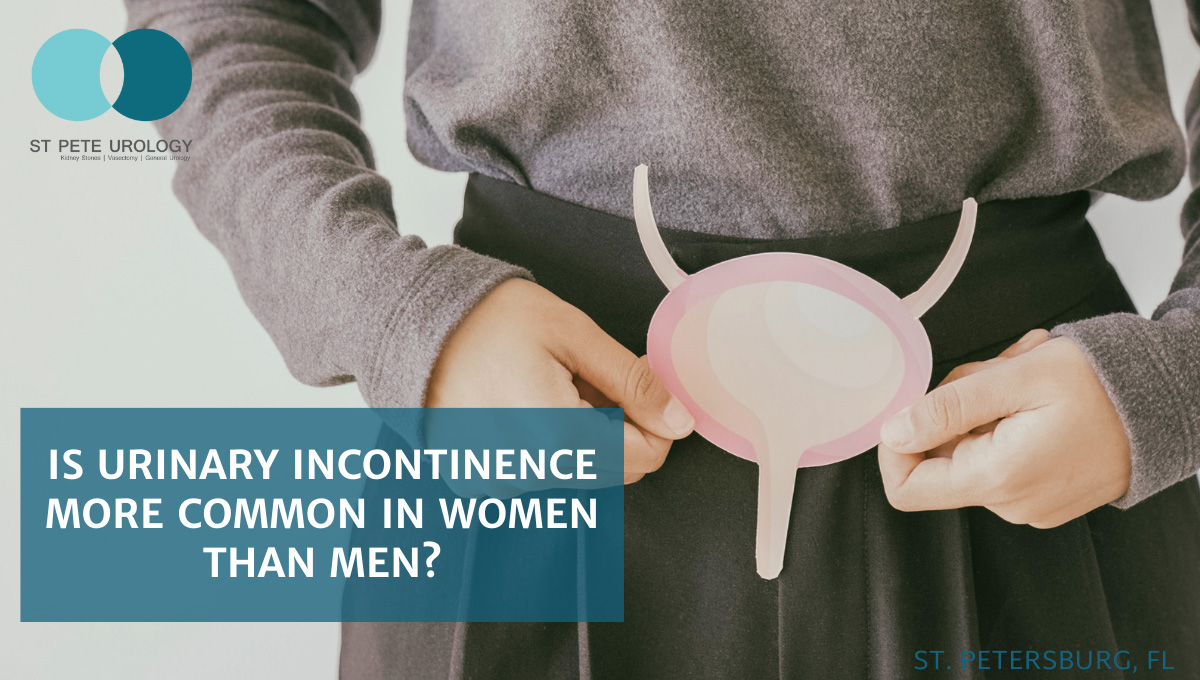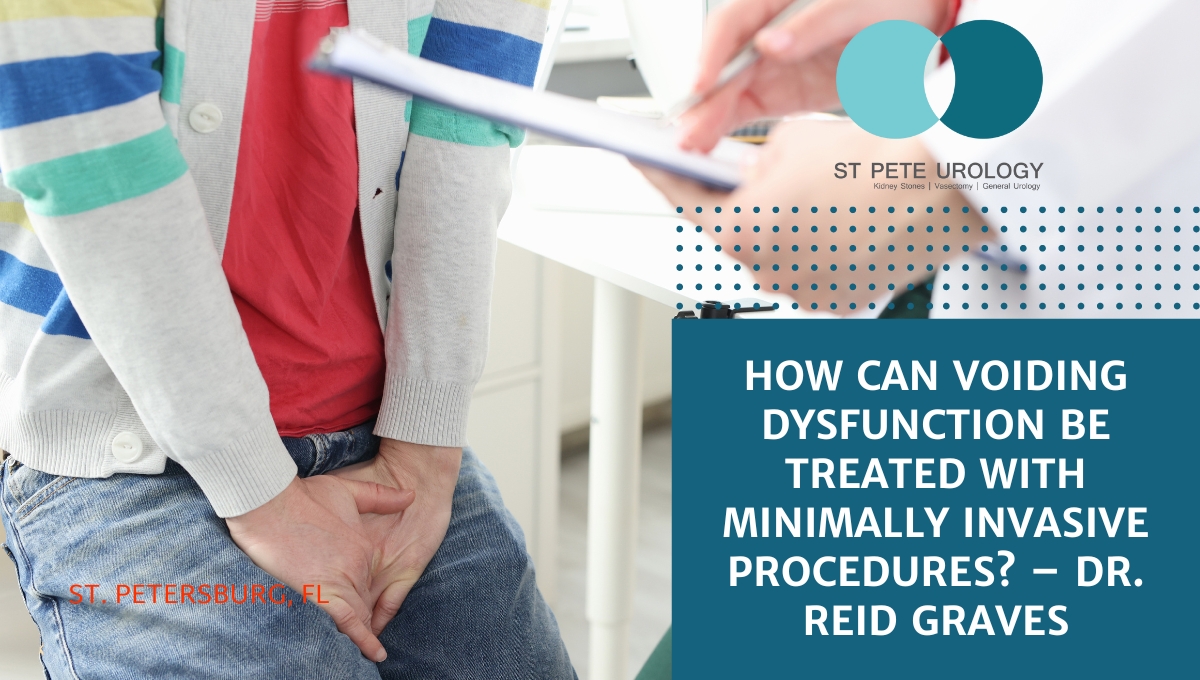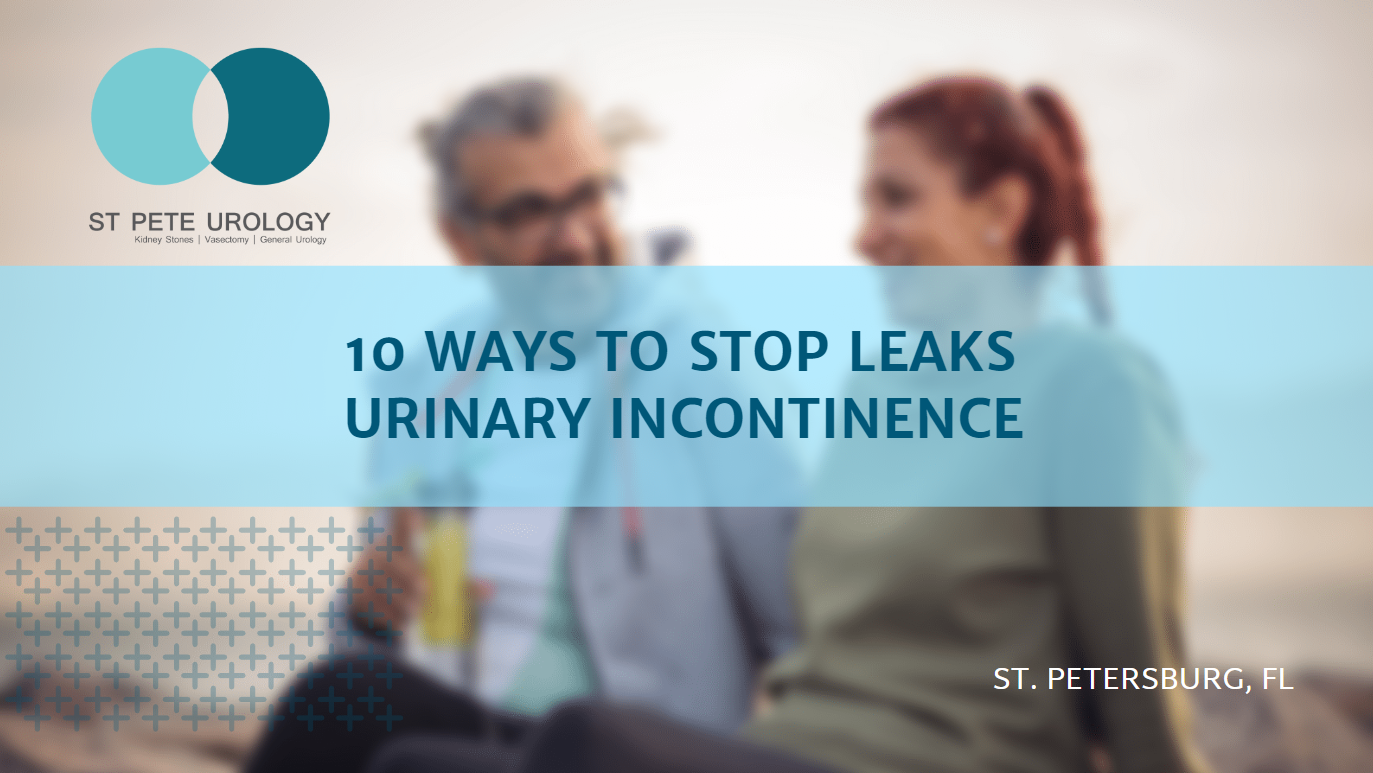Given its critical role in keeping our bodies clean, balanced, and functioning correctly, maintaining a healthy urinary system should be a top priority.
Continue readingIs There a Link Between Diabetes and Urological Disorders?
Recent findings have provided a substantial link between diabetes and urological disorders. Learn about managing diabetes to improve your urological health.
Continue readingIs Your Bladder Healthy? Key Signs to Look Out For
Recognizing the key signs of a healthy bladder is important to monitor its condition and seek medical advice when necessary.
Continue readingIs Urinary Incontinence More Common in Women Than Men?
Urinary incontinence is more common in women than men, but any gender can be affected. Know more about the condition here.
Continue readingWhat Causes Incontinence
Dr. Nicholas Laryngakis discusses the factors on what causes incontinence and the complications and risks associated with the condition.
Continue readingHow Can You Effectively Treat Female Urinary Incontinence?
Key Takeaways:
- The mid-urethral sling procedure is a surgical solution to female urinary incontinence that is minimally invasive and has a high success rate.
- Benefits of the mid-urethral sling procedure include a quick recovery time and return to normal activities within two to four weeks.
- The experienced urologists at St Pete Urology in St Petersburg, Florida, are dedicated to helping patients address urinary incontinence and regain control of their lives.
Introduction
Urinary incontinence is a health concern that affects many women throughout their lives. It is a problem that can lead to a loss of self-esteem and can impact daily activities. However, there is hope for those who suffer from this condition. In this article, we will explore the mid-urethral sling procedure, a surgical solution to female urinary incontinence. As Dr. Adam Oppenheim, a urologist with St. Pete Urology, explains, “the mid-urethral sling is a procedure that we offer for stress urinary incontinence in females.”
Understanding Female Urinary Incontinence
Before delving into the mid-urethral sling procedure, it is essential to understand the underlying condition it addresses. Stress urinary incontinence occurs when pressure is placed on the bladder, causing unintentional leakage of urine. This can happen during everyday activities such as coughing, sneezing, laughing, or exercising. Additionally, it is often a result of weakened pelvic floor muscles, which can be caused by childbirth, obesity, or aging.
The Mid-Urethral Sling Procedure: A Solution for Stress Urinary Incontinence
For women who have bothersome stress urinary incontinence, a surgical procedure known as the mid-urethral sling is often the recommended treatment. This outpatient procedure takes under an hour to complete. Additionally, it shows promising results in addressing the issue of urinary incontinence. According to Dr. Oppenheim, “the patient is then sent home and follows up in the office within a few days.”
How Does the Mid-Urethral Sling Procedure Work?
The mid-urethral sling is a minimally invasive procedure that provides support to the urethra. A small incision is made in the vagina. Then, a synthetic mesh material is inserted to create a “sling” around the mid-portion of the urethra. This sling provides support to the weakened pelvic floor muscles. Furthermore, it helps prevent urine leakage during activities that put pressure on the bladder.
Benefits and Risks of the Mid-Urethral Sling Procedure
There are several benefits to the mid-urethral sling procedure, including:
1. The minimally invasive technique of the mid-urethral sling allows patients to return home the same day as the surgery since it’s an outpatient procedure. They typically have a follow-up appointment in just a few days.
2. The mid-urethral sling has demonstrated a high success rate in treating stress urinary incontinence, contributing significantly to many women regaining their quality of life.
3. The procedure boasts a relatively short recovery time, with most patients resuming normal activities within two to four weeks.
However, like any surgical procedure, the mid-urethral sling carries certain risks, which may encompass infection, bleeding, pain, or difficulties in urination. It’s crucial to discuss these potential risks and benefits with your urologist to determine if the mid-urethral sling procedure is the right choice for you.
Seek Help from Expert Urologists at St Pete Urology
If you are experiencing stress urinary incontinence, it is essential to know that there are effective treatments available, such as the mid-urethral sling procedure. The experienced urologists at St Pete Urology in St Petersburg, Florida, are dedicated to helping patients regain control of their lives by addressing urinary incontinence and providing exceptional care. Let the expert team at St Pete Urology help you take back your life and enjoy every moment without the worry of urinary incontinence.
References:
- “Midurethral Sling: What You Need to Know – Advanced Gynecology.” https://www.advancedgynecology.com/procedure/midurethral-sling/.
- “Treating urinary incontinence – mid-urethral sling operation.” https://www.thewomens.org.au/images/uploads/fact-sheets/Urinary-incontinence-Mid-Urethral-Sling.pdf.
- “Mid-Urethral Sling – Austin Urogynecology.” https://austinurogynecology.com/midurethral-sling/.
Transcription:
I’m Dr. Adam Oppenheim. I’m a urologist with St. Pete Urology. Generally, a surgical procedure known as a mid-urethral sling is offered for women who have bothersome stress urinary incontinence. So the mid-urethral sling is a procedure that we offer for stress urinary incontinence in females. It’s an outpatient procedure that takes usually less than an hour or so to complete. The patient is then sent home and follows up in the office within a few days.
How Can Voiding Dysfunction Be Treated with Minimally Invasive Procedures? – Dr. Reid Graves
Key Takeaways:
- Voiding dysfunction is a common problem among men which can cause frequent trips to the bathroom, difficulty emptying the bladder, and interrupted sleep.
- Minimally invasive procedures, such as green light laser surgery, can provide relief from voiding dysfunction with less blood loss, recovery time, and hospital stays.
- It is important to seek help from an experienced urologist when considering treatments for voiding dysfunction. St. Pete Urology in St. Petersburg, FL is committed to providing quality care to those struggling with this issue.
Introduction: A Common Problem Faced by Many Men
You’re not alone if you’re struggling with voiding dysfunction. It is one of the most common complaints that men have when they seek the help of a urologist. Dr. Reid Graves, a board-certified urologist, practices at St. Pete Urology in St. Petersburg, FL. He is here to assist individuals grappling with this frustrating issue. Let’s explore how minimally invasive procedures can provide relief and improve your quality of life.
Understanding Voiding Dysfunction
Voiding dysfunction can impact men’s lives in various ways, such as frequent and urgent trips to the bathroom, difficulty emptying the bladder, and interrupted sleep. This condition occurs when there’s a problem with the connection between the bladder and the urethra. It’s often caused by an enlarged prostate. This creates challenges as men attempt to urinate, leading to a range of unpleasant symptoms. Dr. Graves emphasizes the importance of finding an effective treatment, stating, “There are many options for treatment in this often difficult area.”
The Wonders of Minimally Invasive Procedures
In the past, treatment options for voiding dysfunction often involved more invasive surgeries. Now, advanced technology has made minimally invasive procedures a reality. These options significantly reduce blood loss, recovery time, and hospital stays. Dr. Graves mentions one popular minimally invasive treatment, saying, “Some of the things patients might have heard of are minimally invasive laser procedures such as the green light laser surgery of the prostate.” He goes on to explain how this innovative procedure compares to the traditional TURP method. In the traditional approach, the inside part of the prostate is removed. This is to improve the connection between the bladder and the urethra.
Green Light Laser Surgery – A Game Changer
Green light laser surgery has revolutionized the way urologists treat voiding dysfunction. This minimally invasive procedure works by removing the obstructing prostate tissue with a laser, allowing for improved urinary flow. Dr. Graves highlights the benefits of this procedure, saying, “The laser allows less blood loss and less hospital stay, and often patients go home the same day.” The reduced recovery time and minimal discomfort make it a preferred option for many men dealing with voiding dysfunction.
Finding the Right Urologist for You
It’s crucial to choose a urologist who has extensive experience and training in treating voiding dysfunction, especially when considering minimally invasive procedures. Dr. Graves assures that at St. Pete Urology, they have had “extensive comprehensive urologic training and it’s one of the best urology programs in the country.” Trusting your care to a skilled and knowledgeable urologist is the first step toward finding relief from voiding dysfunction.
Don’t Suffer in Silence – Seek Help From St. Pete Urology
Voiding dysfunction doesn’t have to control your life. With the innovative and minimally invasive procedures available at St. Pete Urology in St. Petersburg, FL, you can get back to enjoying your daily activities without constant worry about your urinary health. Don’t hesitate to reach out to the experienced urologists at St. Pete Urology, where they’re committed to helping you find the relief you deserve.
References:
- “Voiding Dysfunction – Urology – UCLA Health.” https://www.uclahealth.org/medical-services/urology/conditions-treated/adult-conditions/voiding-dysfunction.
- “BPH Laser Therapy With Greenlight | Laser for Enlarged Prostate.” https://www.treatmybph.com/bph-patient-us/treatment-options/laser-therapy-with-greenlight.html.
- “Voiding Dysfunction – Treatment Options – New York.” https://my.clevelandclinic.org/health/diseases/16394-non-neurogenic-voiding-dysfunction.
Transcription:
Hi, I’m Dr. Reid Graves and I’m a board certified urologist at St. Pete Urology.
One of the most common presenting complaints of men that present to a urology office is voiding dysfunction and trouble with urination. There are many options for treatment in this often difficult area for men to deal with and some of these are maximally invasive and but many of the options we have are minimally invasive.
Some of the things patients might have heard of are minimally invasive laser procedures such as the green light laser surgery of the prostate which is similar to what often people have heard of which is called a TURP where the inside part of the prostate is removed so that patients can void through their prostate which connects between the bladder and the urethra. The laser allows less blood loss and less hospital stay and often patients go home the same day. We had extensive comprehensive urologic training and it’s one of the best urology programs in the country.
10 Ways to Stop Leaks in Urinary Incontinence
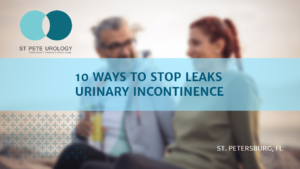

Also, many may experience low self-esteem, body negativity, low physical attractiveness, inadequacy, and reduced sexual desire, which tragically can lead to self-isolation, loneliness, and depression. Plus, accidental urine leaks can compromise daily life activities as you have to continually interrupt your life to use the bathroom.
There are a number of effective treatments for urinary incontinence, including medications, electrical stimulation, medical devices, and surgery. But there is also a lot you can do to reduce the risk of urinary incontinence and to avoid accidental leaks.
Here are 10 ways to stop leaks in urinary incontinence.
Increase your fluid intake
Drinking enough water makes your urine less concentrated. This prevents bladder irritation and minimizes urinary urgency that is usually the immediate cause of urine leakage.
So you shouldn’t stop drinking more water when you have urinary incontinence. Instead, make sure to drink 6-8 ounce glasses of water a day.
An easier way to know you’re drinking enough water is to monitor the color of your urine. Pale yellow urine means adequate hydration, while darker yellow suggests you should drink more.
Empty your bladder regularly
Visiting the bathroom on schedule, every 2-3 hours, even when you don’t feel the urge to pass urine is effective in preventing urine leaks. The strategy keeps urine volume in the bladder low enough to stop accidental leaks.
Another strategy is to always empty your bladder before you leave your house or other venue, like a restaurant or office, even when you don’t feel the urge to go. This will reduce the chances of having an uncontrollable urge to urinate as you travel or go about your routine.
Know where bathrooms are located
When in a new, unfamiliar destination, such as a museum, restaurant, shopping center or park, make sure to know the location of the bathroom. This will enable you to reach the bathroom as soon as you feel the urge to urinate and reduce the chances of accidental leaks.
Keep a bladder diary
If you want to understand the triggers and patterns behind your urinary incontinence, tracking your bathroom habits using a bladder diary is an effective method. In fact, a few days before you visit your urologist, you should start keeping a diary.
Write down what you drink, the time you drink it, the number of times you pass urine, and whether you’ve had urine-leaking episodes. Also, indicate everything that might have caused the accidental leakage, such as exercising, coughing, or a sense of urgency.
Engage in Kegel exercises
Pelvic floor muscle exercises, called Kegels, help strengthen bladder-supporting muscles and in turn prevent urine leaks and urinary urgency due to overactive bladder.
Kegels are quite easy to do. For instance, you can simply tighten or squeeze your pelvic floor muscles (muscles that you use to stop urine flow or the passing of gas) for a count of three, then relax them slowly for a count of three. Build up to doing 10-15 squeezes, 3 times a day, and see your bladder control improve within 6 weeks.
The good thing with Kegels is that you can do the exercise any time, at your desk at work or while sitting in your car.
Lose weight
Losing weight removes the extra pressure on your bladder and pelvic muscles, which can cause accidental leakage. Losing up to 20 pounds of weight over a period of say 6 months can cut bladder leaking episodes by nearly 50 percent.
Cut down bladder-irritating drinks and food
Certain drinks and foods may irritate the lining of your bladder and cause an overwhelming urge to urinate, which may be followed by accidental leakage. For instance, caffeine and alcohol are top bladder irritants. And by limiting alcohol and caffeine beverages, such as tea, coffee, and cola you can prevent urine leaks.
Also avoid bladder irritants such as apples, apple juice, artificial sweeteners, carbonated beverages, chili and spicy foods, chocolate, citrus fruit and juices, milk products, cranberries and cranberry juice, pineapple, tomatoes, sugar and honey, and vinegar.
A good strategy is to try eliminating one or more potential irritants from your diet for 2 weeks, the reintroduce them one by one every few days to see if there is a noticeable difference in your urge to pee, how often you go, and the number of leaks you’ll experience.
Quit smoking
Smoking makes you more vulnerable to urinary incontinence by damaging the small blood vessels in your body and causing tissue weakness. Also, smoking can cause coughing, which may lead to urine leakage by increasing pressure on the pelvic floor muscles.
Plus, cigarette smoking can triple your risk of bladder cancer, which has one of its symptoms as the need to urinate more often or an uncontrollable urge to urinate, even when the bladder is not full.
Review your medications
Some medications can promote urinary incontinence. For example, diuretics increase urine production by the kidneys while muscle relaxants and sedatives relax the urethra and increase the need to pee.
When you suspect your drugs as culprits in your urinary incontinence, speak with your doctor about it. Your physician will determine if the dosage should be changed, if alternatives could be used, or if you should stop taking them.
Treat constipation promptly
With constipation, your colon swells and strains due to excess abdominal muscle pressure. The continuous straining to pass stool weakens pelvic floor muscles and makes urinary incontinence worse. In turn, bladder muscles are adversely affected and the severity of urinary incontinence increases.
Eat more fiber to prevent constipation. Equally, exercise regularly and drink plenty of water. And if you have chronic constipation, speak with your doctor for recommendations on how to manage it, including taking medications or trying physical therapy.
Are you bothered by urine leaks? At St Pete Urology, we encourage you to make the above simple changes to strengthen your bladder and pelvic muscles, reduce bladder irritation, and improve your urinary incontinence symptoms. If urine leakage persists, see your urologist to determine the underlying cause and develop a tailored treatment for you.
For more information on urinary incontinence and other urological problems, visit the site “St Pete Urology.”
How Our Urinary Systems Age With Us


A healthy urinary system works to filter blood and to remove toxins and wastes produced in the body through urine. It also helps to maintain the balance of water, minerals and salts in your blood. Plus, it enables your body to make red cells and regulate blood pressure.
By removing wastes and toxins and regulating fluids and electrolytes, the urinary system helps the body regulate itself and work properly. That is why it’s essential to protect your urinary health as a way of improving your overall health as you age.
In fact, if you take common sense steps early in life to protect your urinary health it will significantly contribute to good overall health later in life especially after the age of 40 years.
So how does your urinary system age with you?
- Kidneys
The number of cells in your kidneys decrease once you’re 40 years or older. This results in thickening of the connective tissue capsule surrounding the kidney and a reduction in the thickness of the cortical region.
The loss of cells causes loss in glomeruli function. And because the glomeruli are responsible for filtration, loss of function of the glomeruli leads to a natural yet gradual decline of kidney function.
Between the ages of 30 and 40 years, the rate of filtration in your kidneys begins to slowly decline, the size of the kidneys begins to reduce and the arteries supplying blood to the kidneys begin to narrow. In turn, your kidneys become more susceptible to injury and kidney disease.
- Bladder
The walls of your bladder and urethra are made of smooth muscles. As you grow older, the muscle tissue weakens and becomes less elastic. In turn, the capacity of your bladder reduces, resulting in difficulty to fully evacuate during urination.
Likewise, the bladder wall generally becomes stiffer as you grow older. This reduces the bladder’s ability to hold as much urine as your younger self. And as your ability to hold urine reduces, you end up urinating more often with a higher risk of urinary tract infections.
Accidental urine leakage results from muscle weakness in the bladder and is more frequent in older people, especially women. More than 50-percent of people aged 65 and older have urinary incontinence symptoms.
By the time you are 80 years or older, bladder control may be sufficiently diminished that many find themselves waking to pass urine during the night.
Various age-related causes of urinary incontinence include:
- Weak pelvic floor muscles
- Nerve damage
- Urinary tract infections
- An enlarged prostate (in men)
The most common treatment options for urinary incontinence are surgery and targeted nerve stimulation.
Another age-related urinary system condition is bladder cancer. Though the disease is not very common, the chance of having it increases with age. In fact, over 70-percent of cases of the cancer are diagnosed in people who are 65 years or older.
Risk factors include exposure to carcinogens, tobacco smoking, and radiation. The most common symptoms are blood in urine (hematuria) and pain during urination. It is advisable to speak with a urologist if you experience these symptoms.
- Urethra
After the age of 40 years, your risk of having urinary tract infections increases due to changes in the urethra. The infections may occur when bacteria invade the urethra, multiply and spread to the upper parts of the urinary system such as bladder and kidneys.
While urinary tract infections are more commonly a concern in aging women, it can also be a problem for men. More than 50-percent of women have urinary tract infections at least once in their lifetime as opposed to just 3-percent of men.
Advancing age is also a factor in UTIs as a result of general immunity weakening with age. Plus, the infections may be more frequent in older people due to urinary incontinence and retention. When not treated promptly, infections that begin in the urethra can in some cases lead to kidney infections and even sepsis.
- Prostate
The prostate is not a urinary organ; it is part of the male reproductive system. However, changes in the prostate result in problems in the urinary system. This is largely due to the prostate gland gradually enlarging after the age of 40 years and leading to extra pressure applied to the bladder, blocking urine flow.
More than 30-percent of men aged 50 years or older require treatment for an enlarged prostate (BPH) while up to 90-percent of men aged 80 years have an enlarged prostate. An enlarged prostate is not cancer, but it is associated with bothersome health issues, such as urinary tract infections, kidney infections, urinary incontinence and bladder damage.
The most common symptoms of BPH are change in urination, inability to start to pee, and a weak urine stream. Speak with your urologist about BPH symptoms as soon as they start in order to get prompt, effective treatment.
Timely urological care
To prevent age-related urinary issues, consider making regular visits to your urologist. The doctor is a specialist with the skills and experience to assess your specific symptoms, ask the right questions, make the appropriate diagnosis and find the right treatment options.
Speak with your urologist as soon as possible to get the right medications or minimally invasive treatment for relief of the symptoms. For more information on the prevention, diagnosis and treatment of urological disorders, visit the site “St Pete Urology.”
What Can Cause Incontinence
Tonight we’re going to talk about bowel and bladder control primarily. So Dr. Graves and I both actually trained together at the university of Pennsylvania in Philadelphia. And we’ve been each practicing for close to 10 years and we’ve had five years of urology training in residency and med school before that. And the topic tonight is something that we do have a lot of focus in and enjoy taking care of and have specialty in. So what causes incontinence of urine or stool there’s a huge host of things that something your doctor can figure out but sometimes it could be something you know is simple. If it’s mild like what you’re eating an excess amount of caffeine it can do that. Some people will be drinking an excessive amount of coffee, you know, I talk to some patients they’re drinking a pot of coffee a day. Other times it really has nothing to do with their diet, medications can do that certain diuretics can predispose to issues with urinary control. If you’re not as physically fit bedridden have other physical mobility issues sometimes that can deal with causing incontinence. And then other things can increase your risk like radiation of the pelvis before a prior injury to the spinal cord or your pelvic floor, certain pregnancy issues or childbirth like such as vaginal deliveries sometimes can have something to do with that. Complicated in terms of regards to different causes but something that is often easy to figure out when you see a physician.


